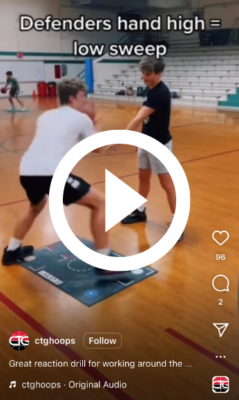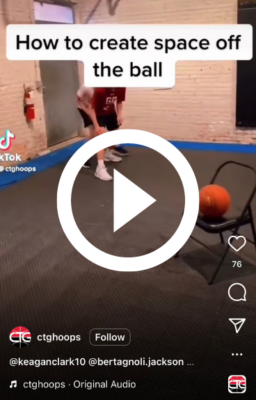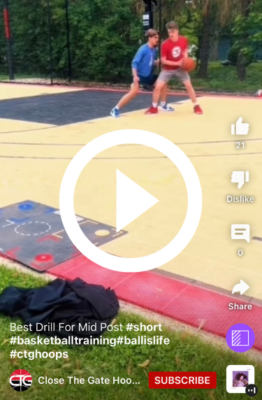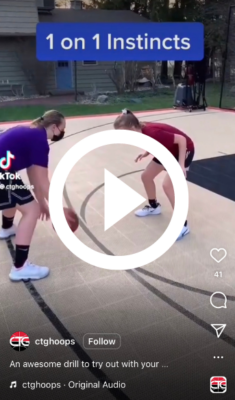There are two ways to structure basketball workouts: blocked training and variable training.
Blocked training is a traditional method commonly focused on developing muscle memory from consistent and repetitive tasks.
Variable training incorporates randomization to develop decision-making with targeted skill development. There still may be repetition in the drill, however, each rep is unique from another because the task is not pre-determined. An example of variable training here at CTG Hoops is the recognition to sweep high or low on a drive based on the defender’s hand placement.
In the drill above, the offensive player doesn’t know where the defense will put their hand to start the possession. This demonstration of variable training incorporates decision-making with skill development via reading the defender and sweeping the ball off the catch to attack. Basketball drills that combine anticipation, recognition, and mechanics in training sessions help to develop a higher probability of success when put in similar situations during an actual game.
We discuss the subtle differences between blocked and variable training more on our Off The Court Podcast seen below.
Tune Into Off The Court: Basketball Training Podcast
It is important to understand that blocked training serves a purpose and certainly supports the foundational skill-set necessary for players to develop. But, if you continue reading we will cover more on the advantages of variable training and why we look to use it so frequently in CTG Hoops training sessions.
ADVANTAGES OF VARIABLE TRAINING IN BASKETBALL
#1 Effectively Transfers To Basketball Games
The objective of any practice is to prepare for the game. Whether it is blocked or variable training, coaches are intentionally structuring workouts to improve a player’s readiness for live competition.
The advantage of variable training over blocked training is the transferable traits developed from simulated game activities. All the set shooting in the world doesn’t necessarily prepare you for the moment of when to pump-fake a defender and attack the basket. By adding cues within a drill, or a live defender to replicate different types of closeouts, then the reps become more comparable to actual game experiences. Variable training adds context to the concept, thus enabling the confidence of a basketball player to be instinctive when it matters most.
#2 Challenging Tasks Reveal Competitive Drive
Skill acquisition and skill development are vital to coaching basketball. Blocked training helps with the initial skill acquisition for basketball players. Coaches often use this as an introduction to the mechanics or fundamentals of particular basketball moves that later serve as the foundation to compete in a game setting.
Consider when being taught how to shoot a layup for the first time:
The instructions were likely laid out in a very simple step-by-step process to ease into the achievement of a fundamental layup, then instructed to repeat the process over again until mastered.
Skill development is the process of challenging these fundamental movements into more complex sequences. The euro-step footwork illustrated above shows how the simple task of a layup can become challenging after adding the complexity of ball and body control. Coaches use variable training to challenge players to build from basic to advanced, which ultimately reveals their competitive drive as a byproduct.
This is why CTG Hoops encourages mistakes and reminds players that failure is everything. Everyone starts from similar paths – being taught the basics – but where our potential peaks depend upon our willingness to compete.
#3 Improves Decision-Making
It is one thing to master the footwork of a particular basketball move, such as the euro-step; it is another to understand when the move should be applied.
This is one of the most significant advantages of variable training: the cognitive development for decision-making in basketball. Blocked training can generate all the tools for a basketball player to be successful, but without knowing when to use any of them, then skill sets hold little value.
This is why if you come to any of our CTG Hoops training sessions, or our upcoming August 3v3 camps you’ll see a lot of variable training involved to help players physically and mentally develop their game!
Check out a few of CTG Hoops top drills to improve decision-making before you go.
1v1 DRILLS TO IMPROVE DECISION-MAKING IN BASKETBALL GAMES
This drill combines ballhandling and reading a defender in transition. Attack downhill with a defender at the nail and make the appropriate ballhandling move based on the defender’s reaction.
The toughest part of shooting off a screen is creating space. Use this drill to work on bumping the defender to create space and reading their path prior to a jump shot. This drill combines decision-making with a change of speeds, footwork, and shot-making.
The best way to read a defense and find ways to score around the rim is to compete 1v1. This drill can be done with a 1st to 5 makes from outside each block and center of the paint. Pro tip: Look to use both hands and ball/body fakes to keep the defender guessing.
This is a great offensive and defensive drill. On offense, the ballhandler is working on anticipation and taking advantage of space to finish at the rim under control. While defenders work agility and recovery by starting at a disadvantage but working to contest the shot attempt without fouling.
KEY TAKEAWAYS FROM THE ADVANTAGES OF VARIABLE TRAINING
- Three Advantages Of Variable Training:
- Effectively Transfers To Basketball Games
- Challenging Tasks Reveal Competitive Drive
- Improves Decision-Making
- #1 Training Company in Wisconsin, here are what people are saying about us . . .
- Play 1v1 drills to improve decision-making in basketball games









